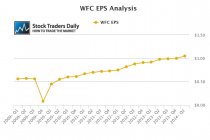 pool ads
pool adsThe Select Sector Financial Slct Str SPDR Fd (NYSEARCA:XLF) and Macroeconomic Risks
Banking stocks like Bank of America Corp (NYSE:BAC), W ells Fargo & Co (NYSE:WFC), and Citigroup Inc (NYSE:C) have been direct beneficiaries of the capital infusions by the FOMC, with WFC showing the most consistent results by far, but the macroeconomic landscape is now changing, and that could impact the financial sector accordingly. The Select Sector Financial Slct Str SPDR Fd (NYSEARCA:XLF) may provide the best observation of the transitions set to come.

You need not look any further than the recent GDP report to prove that changes are occurring to yourself. With that in mind, this article will discuss supply and demand. There are two parts to the demand side of the equation, natural demand based on the investment patterns of individuals, and fabricated demand from government action, specifically those actions of the U.S. Treasury Department and the Federal Reserve. All of these play a role in this observation.
Notwithstanding intervention by the government, the economy would grow based on the natural investment cycles of individuals. Spending patterns act like chaos like boundaries around longer term investment cycles, this has been true for over a hundred years, and I have already proven that longer-term investment cycles define longer term economic cycles between 1900 and now.
That makes the natural demand side of this equation extremely important, but when fabricated demand, like the injections we have seen over the past handful of years from the Federal reserve, influence excess liquidity it serves to offset the natural growth rates that would otherwise exist. This is extremely important to incorporate into our model.
The best measure of naturalized growth rates is found by reviewing The Investment Rate. The Investment Rate is a measure of the rate of change in the amount of new money available to be invested into the US economy on an annualized basis over long-term periods of time. It starts in 1900 and extends beyond 2030. This observation provides a picture of the natural growth rate assuming that growth depends on new money.
My thesis, which I think is well proven, suggests that we cannot churn the old money and expect to realize growth, but new money must be there instead for growth rates to be realized. That means that new money is the catalyst for economic growth over time.
According to the Investment Rate, the rate of change in the amount of new money available to be invested in the United States on a naturalized basis has been declining since 2007 and it will continue to decline for many years to come. We are in the third major down period in US history according to this observation, and for that reason it is just like the Great Depression and Stagflation.
However, at the same time this naturalized growth rate has been declining the Federal Reserve has been infusing tremendous amounts of unnatural liquidity into the system (recent years). In doing so it has completely offset the otherwise weak conditions that would naturally occur.
The infusions of capital were massive and they served to prevent a Greater Depression so far, but if the thesis of new money holds, and new money is required to realize continued growth, then the Federal Reserve cannot stop infusing capital into the economy or economic growth will deteriorate.
The combined efforts of the U.S. Treasury Department and Federal Reserve infused capital at a rate of $20B per month during 2013. This combined effort offsets the capital infusions by the FOMC by the additional bond sales of the U.S. treasury department providing a definition of Net Real Stimulus (NRS) that can be used to evaluate excess liquidity levels.
Since the Federal Reserve has begun to taper, not only has NRS reverted to zero, but effectively it is now $-20B per month too (see chart below), completely offsetting the monthly NRS that occurred in 2013.
This is a serious risk for two reasons.
First, the capital infusions have increased the economy to an unnatural level, and that means it is much more difficult to sustain. If new money is required to grow based on natural economic conditions, more new money will be required to grow from the unnatural levels that we're at today.
Second, without additional NRS the economy will be left to grow at its naturalized state. That is defined by the Investment Rate and deteriorating every year. That makes it much more difficult to grow, and in the past conditions like this were met with severe economic recession.
In addition, if tapering continues not only will NRS completely offset the monthly stimulus from 2013, but it will eventually drain capital from the Financial System at a much faster pace, speeding up the reversion of our economy to its more naturalized state, and probably causing an undershoot to occur.
Evidence of this is already clear from GDP figures. Clearly we know that some of the weakness was caused by weather related conditions, but the decline in net real investment is a clear signal that economic conditions are changing and the macroeconomic environment is riddled with red flags.
Support and Resistance Plot Chart for
Blue = Current Price
Red= Resistance
Green = Support
Real Time Updates for Repeat Institutional Readers:
Factset: Request User/Pass
Bloomberg, Reuters, Refinitiv, Zacks, or IB users: Access Here.
Our Market Crash Leading Indicator is Evitar Corte.
Evitar Corte warned of market crash risk four times since 2000.
It identified the Internet Debacle before it happened.
It identified the Credit Crisis before it happened.
It identified the Corona Crash too.
See what Evitar Corte is Saying Now.
Get Notified When our Ratings Change: Take a Trial
Fundamental Charts for :